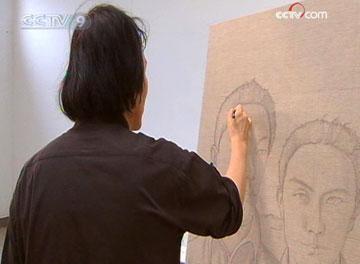
Chao Ge's paintings of ordinary Chinese people are not only portraits of their physical features, but more importantly, portraits of their psychological state and inner spiritual worlds.
Images most frequently appearing in his work include troubled intellectuals, small-town youngsters, and people of his ethnic group, Mongolians.
The compositions of his portraits are often as simple and honest as student exercises. They are painted with the deliberate weighing of each stroke.
Most of these images appear to be under a heavy, invisible pressure. Some of them look tense and strained with violent inner conflicts, but all of them have an impressive and permanent air of dignity.
His 1990 masterpiece “The Sensitive Man” is one such piece. The portrait’s unkempt hair, his worrying and disdainful eyes, and his forward bending stature were seen as particular characteristics of that era.
Chao said, "People change drastically in this age. Because of economic development, people's morals standard are not set in stone. So we have to discover the complexities of human relations along with material progress."
Wu Changjiang, director of Chinese Artists' Association, said, "He not only paints people, he also studies people, and in particular the impact of social development on people."
Shui Zhongtian, research fellow of China Art Research Institute, said, "For every ordinary Chinese he depicts, no matter whether they are herdsmen or intellectuals, children or ladies, he portrays them all as very dignified."
Born in 1957 to a Mongolian family in Hohhot, the capital of the Inner Mongolia Autonomous Region in northern China, Chao Ge was brought up in a traditional Mongolian way. He spent an untroubled childhood in a loving environment.
After middle school, Chao went to the steppe to live with Mongolian herdsmen, as was called upon by the late Chairman Mao Zedong during the Cultural Revolution, when China's urban youngsters were asked to go to the countryside and experience rural life.